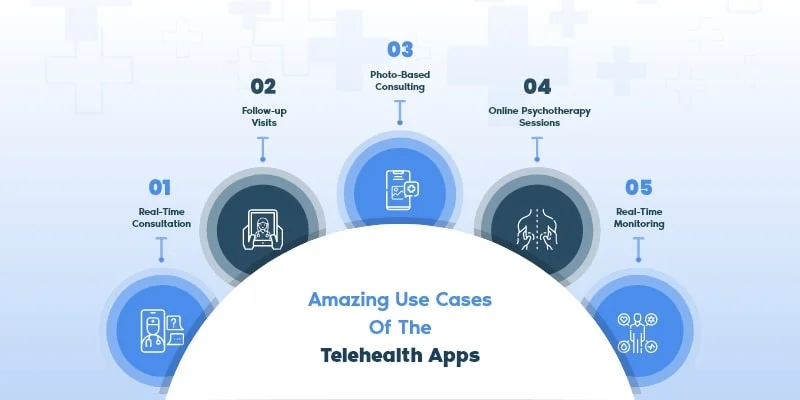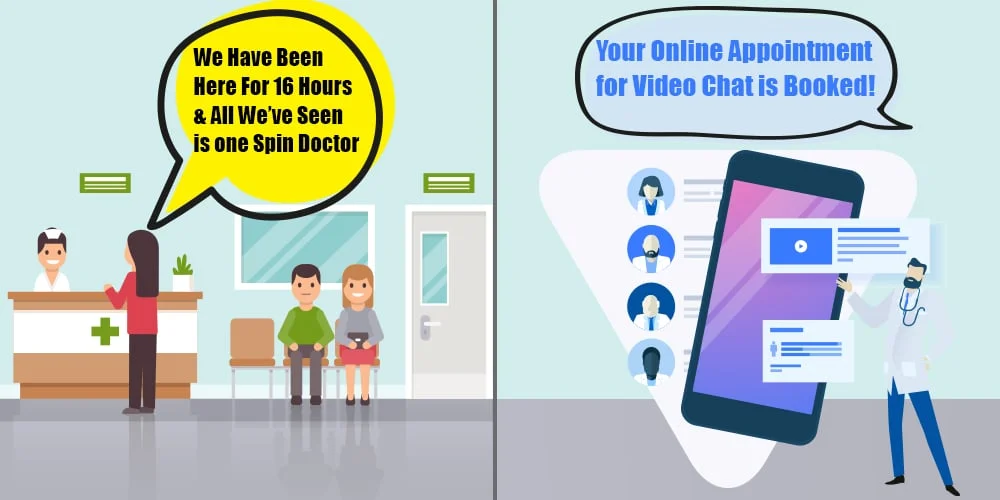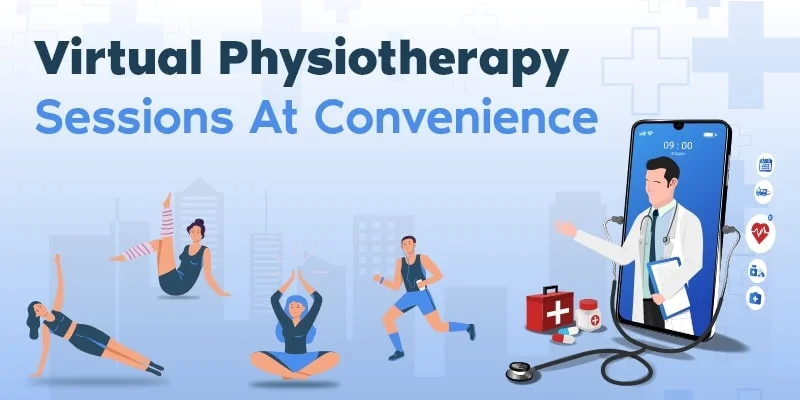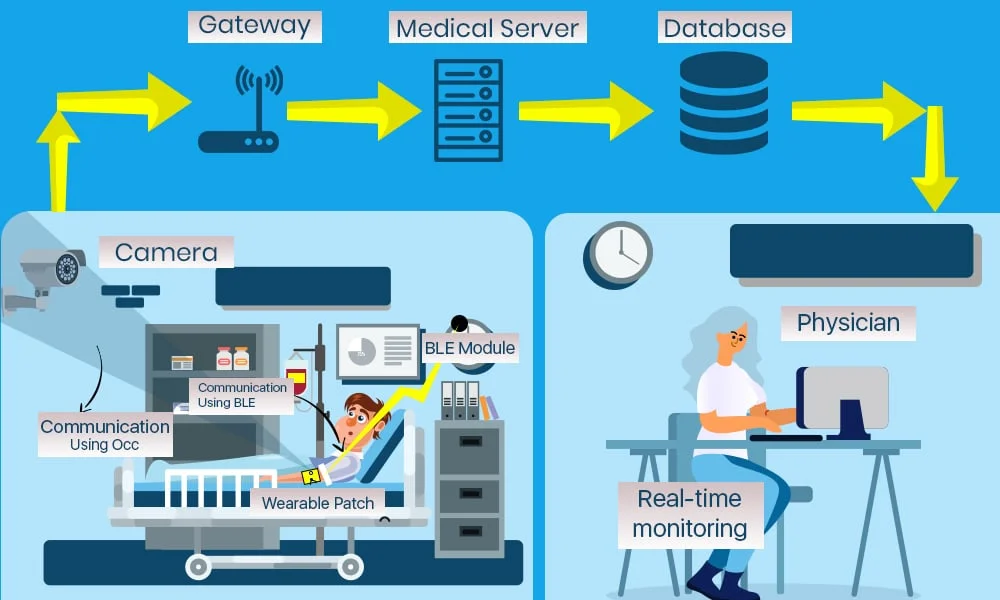Quick Overview: Here, we’ll talk about everything on how to develop a telemedicine app. The process includes thorough market research, defining essential features like video consultations, appointment scheduling, and secure data storage, and ensuring compliance with healthcare regulations like HIPAA and GDPR. Keep reading for more info.
Healthcare is no longer confined to clinics and hospitals. With over 60% of patients preferring virtual care, telemedicine apps have become a game-changer.
They bridge the gap between patients and providers, offering instant access to medical expertise. For example, a busy professional can consult a doctor during a lunch break, or a senior citizen can get follow-ups without the hassle of travelling.
In fact, the telemedicine market is projected to reach USD 225 billion by 2030 at a CAGR of 17.16%. It shows that these apps are rapidly becoming essential for both patients and providers.
Are you a doctor who wants to be a part of the telemedicine app platform?
or
Want to know how to build a telemedicine platform for your clinic or healthcare organization? Or perhaps you’re looking for the best telemedicine startups? Then this article is for you.
In this draft, you will know the need for the mhealth app and why telemedicine app development is a need for the hour.
Let’s first deeply understand telemedicine.
What is Telemedicine Technology?
Telemedicine, also referred to as Telehealth, is a practice which provides efficient evaluation, diagnosis, and treatment of patients from remote locations.
In a simple word, a patient does not have to be present at the hospital for his diagnosis and treatment. Healthcare professionals can quickly provide medical facilities and remote care to patients using solutions resulting from telemedicine software development. It encompasses a range of technologies such as video conferencing, mobile apps, wearable health devices, and AI-driven chatbots.
The reduced cost for medical facilities and seamless operations have made e-health a much-appreciated method. And that’s what has catalyzed telemedicine application for healthcare among clinicians.
Benefits of Building a Telemedicine App for Doctors and Healthcare Professionals
Here’s how developing a telemedicine app & on-demand doctor app development aids doctors and patients.
Real-Time Consultation
Imagine a scenario, where you are paranoid after finding some symptoms that match the article you have read or heard about somewhere.
Most likely, you would Google that, and it is no surprise that a Google search will only worsen your fear. You would want to discuss it with a doctor but you have to pass through certain procedures like booking an appointment, travelling to the hospital, filling out forms, etc. Meanwhile, you have already come to the gravest conclusions on what may have happened to you.
This is where healthcare service providers can leverage telemedicine applications with integrated patient engagement software. It facilitates communication and interaction between patients and healthcare providers. Leveraging this integration, you can improve the patient’s experience. It provides tools to manage appointments, access health records, receive treatment recommendations, and monitor health status through online portals.
Quite an improvement from the first scenario. Isn’t it?
On the whole, from the patient’s side, it reduced the time taken to consult the doctor, and from the doctor’s perspective, it saved time that doctors could use to examine and diagnose other patients.
Follow-up Visits
We can understand that it is indispensable to be physically present at the clinics if the patient has some critical disease or any physical injury that requires routine check-ups. But what if the physical examination is not needed and the problem can be just solved by video chat or other telehealth solutions?
Often time follow-up trips are costly for the patient and for the examining doctors as well. And this can be only eliminated by providing a more convenient method to the patient. With this intention, various telehealth business ideas for mobile apps are being developed by myriads of healthcare professionals.
Photo-Based Consulting
Similar to the first use case, this is also another application to provide faster and more efficient treatment to the patient irrespective of his location. Photo-based consulting allows the patients to upload a photo of a problematic spot and send it to the server. Once the doctor gets the notification, he can diagnose the problem and respond with a treatment for the disease, or if further information he can schedule a video call or send it further for a lab test via mobile.
Some specialists, such as dermatologists, believe that they can identify the cause and problem just by looking visually once or twice. In a similar manner, skin disease, eye infection, bruises, and other similar conditions with visible symptoms do not require personal consultation.
Physicians or doctors can save resources by opting for telemedicine software development. They can attend to cases from anywhere and anytime.
Online Physiotherapy Sessions
According to Mental Health America, one of the major health problems America faces is mental illness. As per their report, over 44 million American adults are suffering from mental health issues.
Most of them think going to a clinical psychiatrist is shameful. They fear society. However, there has been some improvement in such a rigid mentality about mental health, and people are becoming aware of it. The psychologists are providing personal sessions directly to the person’s home.
One-step further, telemedicine has allowed online counseling to be a part of medical treatment. Now, the psychotherapist can take counseling sessions through the mobile app. While the benefits of telemedicine app development are clear for patients, they don’t have to be ashamed of their mental condition. They can directly schedule a session on a mobile phone, regardless of their location.
The advantages of developing a telemedicine app like BetterHelp allow psychologists to earn a little more than they are currently earning and start their side income. Not only practitioners but retired psychologists can also take sessions and earn through their homes.
Real-Time Monitoring
The advancement in telemedicine platforms for doctors has increased their scope for remote health monitoring amongst patients.
If we believe the existing medical surveys to be true, then telemedicine is capable of taking care of patients with cardiac disease, asthma, and heart failure. They can be easily monitored on a real-time basis, regardless of location. This application of mhealth has made it easy for the people of the small and remotely located town where high technology healthcare providers and clinics are not available.
If the smartphone doesn’t have the required functionality and sensors, wearable sensors are useful for continuous monitoring, storing, and sending data to healthcare professionals over distance.
Hence, these sensors are useful in constantly monitoring the health indicators and body positions of the patients and keeping track of sports and other activities.
Now that you are acquainted with the vast usage of telehealth, let’s take a glance at the popular features of telemedicine mobile apps.
Features of Telemedicine Apps
Telemedicine apps work as a boon for doctors and patients both. Here are the essential features that make these apps successful:
These features not only enhance user experience but also ensure the app’s competitiveness in a growing market.
By following these steps, you can create a robust, compliant, and user-friendly telemedicine app like Teladoc, revolutionizing the way healthcare is delivered.
How to Build a Telemedicine App Like Teladoc? 7 Key Steps Explained
To develop a telemedicine app, you need to follow some crucial steps in order to launch a bug-free app. Here’s a comprehensive 7-step guide to help you through the mobile app development process:
Step 1: Conduct Market Research and Define Your Niche
The foundation of a successful telemedicine app is thorough market research, hence, start by analyzing the telemedicine industry. Identify your target audience based on demographics, healthcare needs, and geographic location. For example, Teladoc serves diverse niches such as mental health, chronic condition management, and general consultations.
Explore existing competitors to understand their strengths and weaknesses. For instance, Teladoc excels in user trust and diverse services but might lack certain personalization features. Pinpoint gaps in the market and define your unique value proposition. Are you focusing on mental health? Or perhaps providing specialized care for chronic conditions? A well-defined niche can set your app apart.
Step 2: Establish Compliance with Healthcare Regulations
Healthcare apps must have data security and privacy. Compliance with regulations is non-negotiable, as non-compliance can lead to legal penalties and loss of trust.
HIPAA (U.S.): Mandates secure storage and transmission of Protected Health Information (PHI). Features like encrypted communication and secure user authentication are essential.
GDPR (Europe): Focuses on user consent and data minimization for EU residents.
PIPEDA (Canada): Requires secure handling of personal data with explicit consent.
Consult legal experts to ensure your app adheres to all relevant regulations. Incorporate secure data encryption, two-factor authentication, and access controls to safeguard patient information. Regular audits and updates to your compliance practices will help you stay ahead of evolving regulations.
Step 3: Telemedicine App Features
We’ve already mentioned the features of telemedicine apps in the above section, you can choose the features as per your requirements and keep upgrading your app with the advanced features in the later phase.
We would suggest you go with the required features in the initial phase. This would help you to lower the development cost, and check on the feedback of the users.
Step 4: Choose the Right Tech Stack
Choosing the right tech stack plays a major role in the success of a telemedicine application. Here, we have provided some of the best technologies for developing a telemedicine app.
Backend: Node.js, Python (Django), or Ruby on Rails for server-side logic.
Frontend: React Native or Flutter for cross-platform compatibility. These frameworks reduce development time and cost by allowing a single codebase for both iOS and Android.
Database: MongoDB or PostgreSQL for secure and scalable data storage.
Video APIs: Twilio or WebRTC for secure real-time communication.
Cloud Services: AWS, Google Cloud, or Microsoft Azure for scalability and reliability.
Ensure your tech stack supports future updates and integrations. Use CI/CD pipelines to streamline development and deployment processes.
Step 5: UI/UX Design of App
The mobile app designe services you hire must have experience in developing UI/UX designs that enhance user retention. Here are a few steps to follow for your UI/IX design of a telemedicine app.
Wireframe the app’s structure and test prototypes with real users to identify pain points. Use tools like Figma or Adobe XD to create engaging designs. Collaboration between designers and developers is key to ensuring design feasibility.
Step 6: Telemedicine App Development
Basically, this phase of a mobile app development process is divided into three parts, i.e., frontend, backend, and API integration.
Step 7: Test & Deploy
Once your telemedicine app is developed, it’s time to go for rigorous testing. Typically, some of the most appropriate testing performed are usability testing, functional and non-functional testing, performance testing, and more.
After testing the app, deploy the app on platforms like the App Store and Google Play. Follow these steps:
By following these steps, you can create a robust, compliant, and user-friendly telemedicine app like Teladoc, revolutionizing the way healthcare is delivered.
Challenges Faced in Building a Telehealth App
Developing a telehealth app is certainly not a piece of cake. Mobile app development companies will encounter several hurdles during the app development process. Let’s take a closer look at these challenges.
Data Security:
The security of patients’ data is one of the prime concerns you will have to address if you really want to get trustworthy telemedicine software development for your business. Patient’s health records and personal information are very sensitive information and if your app doesn’t have solid security, your app might fall short of fulfilling users’ expectations.
Ensure that the healthcare app development company you hire to develop a telehealth app takes extra care while designing the database.
Put emphasis on the reliable framework. Your telemedicine app developers should make sure that they are using the latest and most secure frameworks and libraries. Use HIPAA-compliant data storage platforms like AWS (Amazon Web Service).
UI/UX Design
Unlike apps that serve one particular side of users, telemedicine apps have to consider both sides of users (i.e., doctors and patients). Hence, the interfaces they will engage in will have different kinds of content and feel. For that, you will have to create separate apps for patients as well as doctors.
So, telemedicine app development may take a little more time than the development of normal apps.
Backend Integration
Backend integration makes sure that the data moves from the patient’s end to the doctor’s end. However, the process of implementing a backend in a telehealth app is far more challenging than any other kind of app.
Also, all the features you are going to include should follow HIPAA compliance. App developers also have to consider other third-party service integrations for location, payment, and other aspects. These all take a little more effort.
Why HIPPA-Compliant Telemedicine App Required?
Building a telemedicine app that is HIPAA-compliant is not just a regulatory requirement—it is essential.
1. Protecting Patient Data Privacy
Telemedicine apps handle sensitive patient data, including medical histories, diagnoses, and prescriptions. HIPAA compliance ensures that this Protected Health Information (PHI) is stored, transmitted, and processed securely. For example, encryption, access controls, and secure communication protocols safeguard patient information against unauthorized access or breaches.
2. Building Patient Trust
Patients need assurance that their medical data will remain confidential. A HIPAA-compliant app demonstrates your commitment to maintaining the highest privacy standards, building trust with your users. Trust is critical for user retention and the long-term success of your app.
3. Avoiding Legal and Financial Penalties
Non-compliance with HIPAA regulations can result in severe penalties, including fines ranging from $100 to $50,000 per violation. Beyond financial losses, legal issues can damage your app’s reputation. Ensuring compliance from the start prevents these risks.
4. Enabling Seamless Collaboration
HIPAA compliance enables secure communication between patients, doctors, and other healthcare providers. Features like encrypted video consultations and secure messaging ensure that all parties can collaborate effectively without compromising data integrity.
By prioritizing HIPAA compliant app development, you not only adhere to legal requirements but also position yourself as a trusted platform in the competitive healthcare market.
How Much Does it Cost to Develop a Telemedicine Application?
The cost of building a telemedicine app depends on several factors, including the app’s complexity, features, and compliance with healthcare regulations. On average, the cost can range from $20,000 for a basic app to over $300,000 for a feature-rich, scalable solution.
Also, key aspects such as the choice of technology stack, user interface design, and third-party API integrations heavily influence the final cost. For instance, incorporating advanced features like AI-powered symptom checkers or wearable integrations will significantly increase expenses.
Another major cost determinant is the mobile app development compay you hire for your app. The geographic location of the development team also impacts pricing, with regions like Asia or Eastern Europe offering cost-effective yet skilled options compared to North America or Western Europe.
Compliance with healthcare regulations like HIPAA or GDPR adds further to the timeline and cost, as it requires secure data handling, encryption, and legal oversight. Post-launch expenses, including server hosting, regular maintenance, and marketing efforts, are also crucial to consider.
While creating a telemedicine app requires a significant investment, it offers immense potential in addressing the rising demand for accessible, remote healthcare solutions.
For detailed information on how much does it costs to build an app, you can refer to this guide. It gives you every piece of information for your app development, like Teladoc.
Discover how we’ve bridged the gap between doctors and patients with seamless telemedicine solutions.
Explore Our Portfolio on Telemedicine App For Patients and Doctors
Best Telemedicine Platforms for Healthcare in the Current Industry
In some situations, at least an interim solution is needed for non-emergency concerns. In this case, top telemedicine apps come to the rescue. As discussed earlier, these applications aligned with telehealth trends for various purposes-from appointment booking & consultation to the real-time monitoring of the patients. Here is the list of Telemedicine software platforms.

Teladoc
It is one of the best telehealth platforms, providing services to its users in countries like the USA and 16 other countries. Besides, its online treatments include general medical care, mental health, dermatology, nutrition, sexual health, and many more.
The total number of visits on Teladoc now is over 50 million, with the top quality doctors giving their best for the patients through phone, web, or app. It has created huge profitability for itself as it has been working toward advancing the healthcare industry for a long time now.

Lemonaid
The app is a simple and affordable way to visit the doctor online at your convenience. $25 doctor consultation fee plus the delivery of the prescribed medicine is free. All you have to do is answer some basic questions asked regarding your health problem.
Wait for one or two hours for the doctor’s diagnosis and get advice from the doctor online. Additionally, the app will help you out by connecting you with the nurse practitioner on a video call.
They will guide you as per your medical condition and history and provide you a consultation on meds optimally and safely.

PlusCare: Medical Doctor Care
One of the best apps for those who prefer to have an online visit rather than going to the clinic physically. Book your appointment with the USA’s top doctors and get diagnosed or have a consultation on your medical condition on a video call.
One thing that differentiates PlusCare from other apps is its feature, which allows users to use their insurance card.

Talkspace Counselling & Therapy
This app has come as a lifesaver for those who are struggling with their mental issues. The app has all the features that let you find the best therapist in the country. You can easily choose the best according to your need and schedule sessions as per both party’s convenience.
Features like unlimited chat options, photos, videos, and recordings allow the user to utilize the best possible way to feel better. You will be able to see the psychiatrist’s bio and her certificates.

Doctor On Demand
Consider it as the hub or a doctor’s house. You will find all kinds of doctors who have specialists in various lines. Log in, connect, and consult a psychiatrist, physiotherapist, pediatrician, physician, and whatnot.
You will get advice and treatment from medical to mental health on this telemedicine app. Most importantly, the doctors are available at your service 24/7.
It will provide you with the convenience you need. Never forget to check out how much the online visit will cost you. With such on-demand doctor app development you can ease the work of patients and reach out to them easily.

Babylon: Healthcare and Medical Advice
This UK-based telehealth app is the same as the above-mentioned app, but what makes it worth trying is its ability to find millions of symptoms within a second using a symptom checker.
The Babylon health app has some free and easy-to-use tools to help you know the health risk factors, and build a health profile to live a healthy lifestyle. The UK’s Care Quality Commission regulates the app, so it is safe and advisable.
So, these are a few examples of the best telehealth software systems in healthcare. If you are interested to build telemedicine platform, you can take inspiration from these apps and add unique ideas and features to your app.
How Excellent Webworld Helps You to Develop a Telemedicine App?
When considering how to develop a telemedicine app, one of the critical aspects is understanding the nuances of the healthcare industry. Excellent Webworld being an experienced telemedicine app development company, brings domain expertise, helping you navigate complex regulatory requirements like HIPAA, GDPR, and PIPEDA to safeguard patient data and build trust.
Our team employs proper tools and frameworks to deliver essential features such as video consultations, appointment scheduling, e-prescriptions, and AI-powered symptom checkers. We ensure every element of the app is designed to enhance user experience and accessibility.
What sets us apart is our customer-centric approach. Whether you’re looking to replicate Teladoc’s functionality or create something unique, we collaborate closely to align the app’s design and features with your vision.
Partnering with Excellent Webworld is your answer to how to build a telemedicine app that stands out. Let us help you bring your telemedicine app idea to life and create a lasting impact in the healthcare industry.
Frequently Asked Questions
The future of telemedicine is set to grow with advancements in AI, wearable technology, and 5G connectivity. These innovations will enable more accurate remote diagnostics, real-time health monitoring, and faster consultations. Expanding adoption, regulatory support, and patient demand for accessible healthcare will continue to drive its evolution.
Ehealth encompasses the broader use of digital technology in healthcare, including health apps, electronic medical records, and online health education. Telemedicine, on the other hand, focuses specifically on remote medical consultations and care delivery via video calls, messaging, or other virtual platforms.
Building a telemedicine app involves technologies like Twilio or WebRTC for secure video consultations, Stripe or PayPal for payment integration, and cloud platforms like AWS for scalability. AI-driven tools for symptom checking and wearable device integration for real-time health monitoring are increasingly common in advanced telemedicine solutions.
The cost to build a telemedicine app ranges from $50,000 to $300,000, depending on the complexity and features. Factors like regulatory compliance (e.g., HIPAA), the development team’s location, and advanced functionalities like AI or wearable integration significantly influence the final cost.

Article By
Mayur Panchal is the CTO of Excellent Webworld. With his skills and expertise, He stays updated with industry trends and utilizes his technical expertise to address problems faced by entrepreneurs and startup owners.







